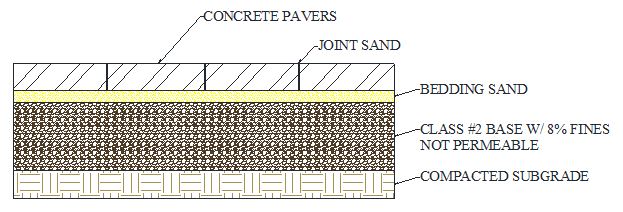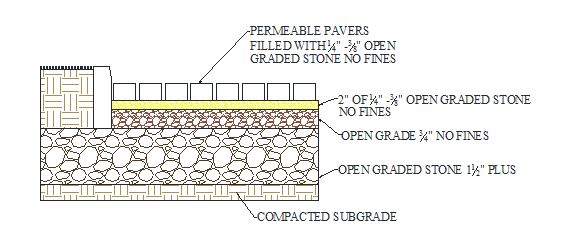Permeable pavers are often confused with regular pavers. However, these two pavers work differently and hence should not be used interchangeably.
So what sets them apart? Let’s break it down to two factors – first is their base and next is the joints or gaps between them.
Base beneath
Pavers aren’t just laid on the ground surface. Installation involves preparing a base and how the base is set up defines the purpose they serve.
The standard interlocking paving stone is not permeable, which means it does not drain water. While regular pavers are designed to be flexible, they are not meant to be permeable. Let’s take a closer look into the base of a regular paver and a permeable paver.

At the base of regular pavers, you’ll see large gravel, medium sized gravel, small gravel and what is called fines (very small particles). This mixture of varying gravel sizes creates a compact well. Add to that the fines that fill the already narrow voids, making the layer even tighter.
This base material is not meant to drain water but rather to prevent water from draining through it.
On the other hand, the base materials for permeable pavers are referred to as open graded. This is because it is made up of larger pieces of gravel. This large gravel pieces leave voids, which then allows water to pass through easily. See this figure below.

The purpose of permeable pavers is to allow the water to drain through the aquifer.
In order to do that, the water must pass through the pavers, the open graded base, and then the subgrade or subsoil until it arrives at aquifer or ground water.
Gaps in between
Take a look at the photos below. See how the gap size between pavers differ? For permeable pavers, the joint size is wider as compared to a standard paver.
Left: Permeable Pavers, Right: Concrete Pavers
Regular pavers should be treated just like any solid surface such as concrete. The surface should slope away from the house and surface drains should be installed as needed to handle the water.
Permeable pavers are designed to allow the water to drain through them and into the open graded base and then into the soil, called the sub soil.
The opened graded base may consist of several different sizes of rocks but we will refer to it as open graded base. The water does not automatically seep into the soil below called subgrade or subsoil, and this open graded base acts as a holding tank.
The design and depth of this holding tank depends on several factors: the subgrade, the area runoff, the amount of rain fall for your region, and the slope of the pavers and extreme slopes.
We’ll cover these factors in our next post so if you want to be sure your permeable paver is designed correctly, then check that out as well.